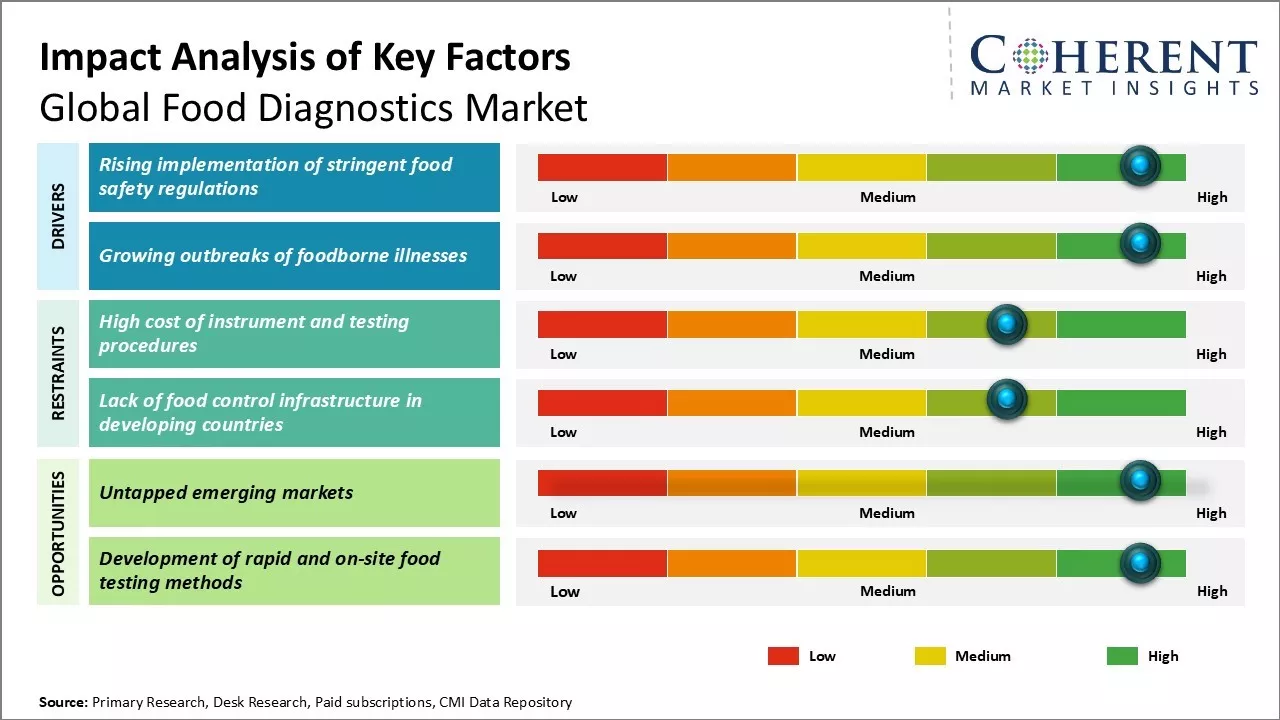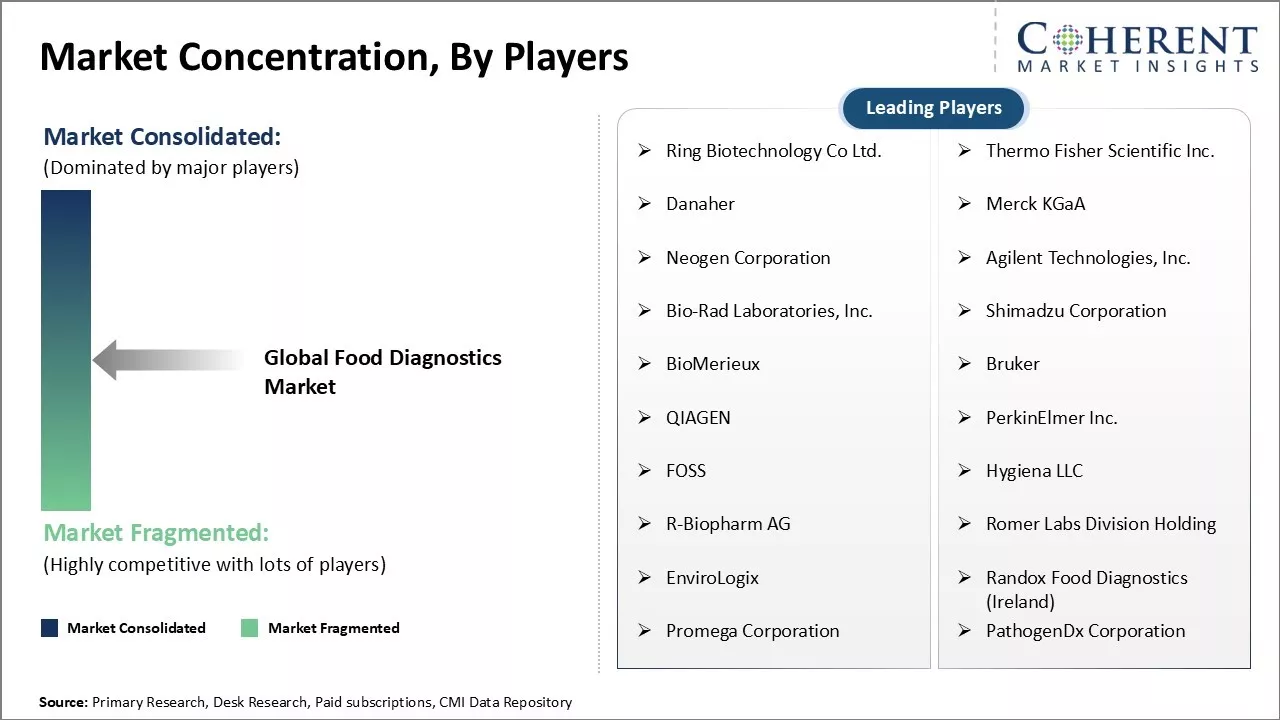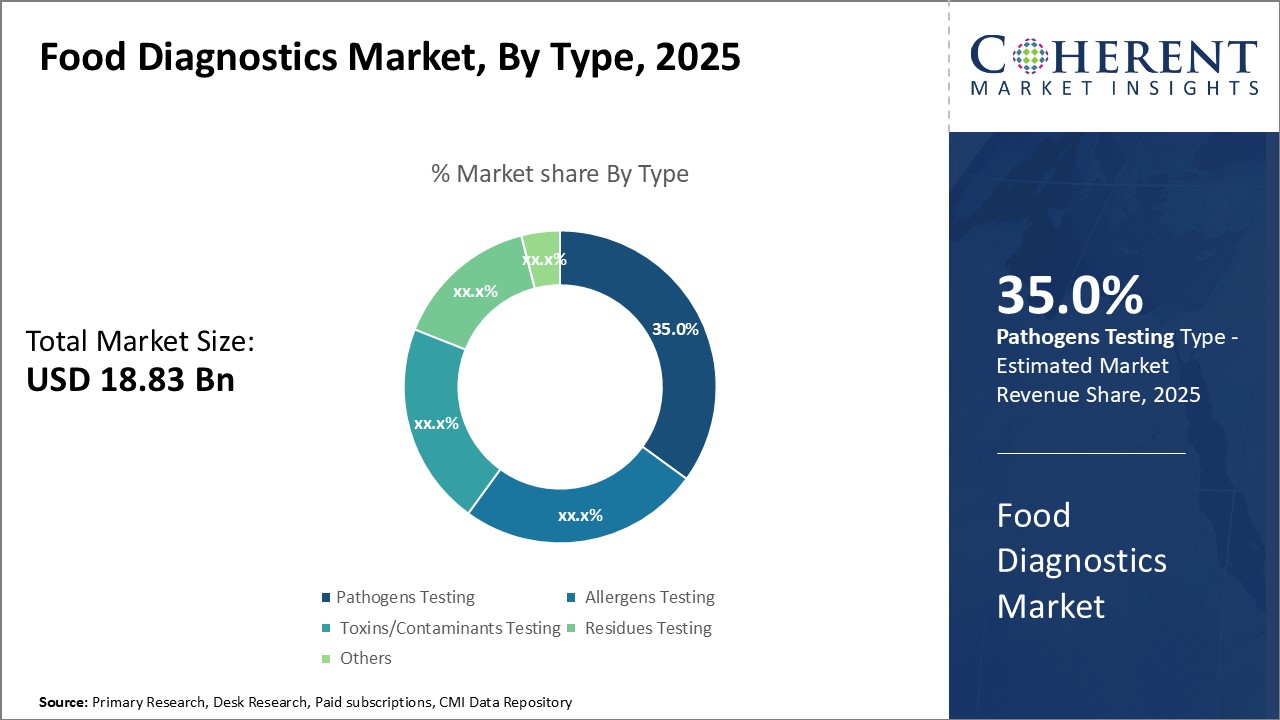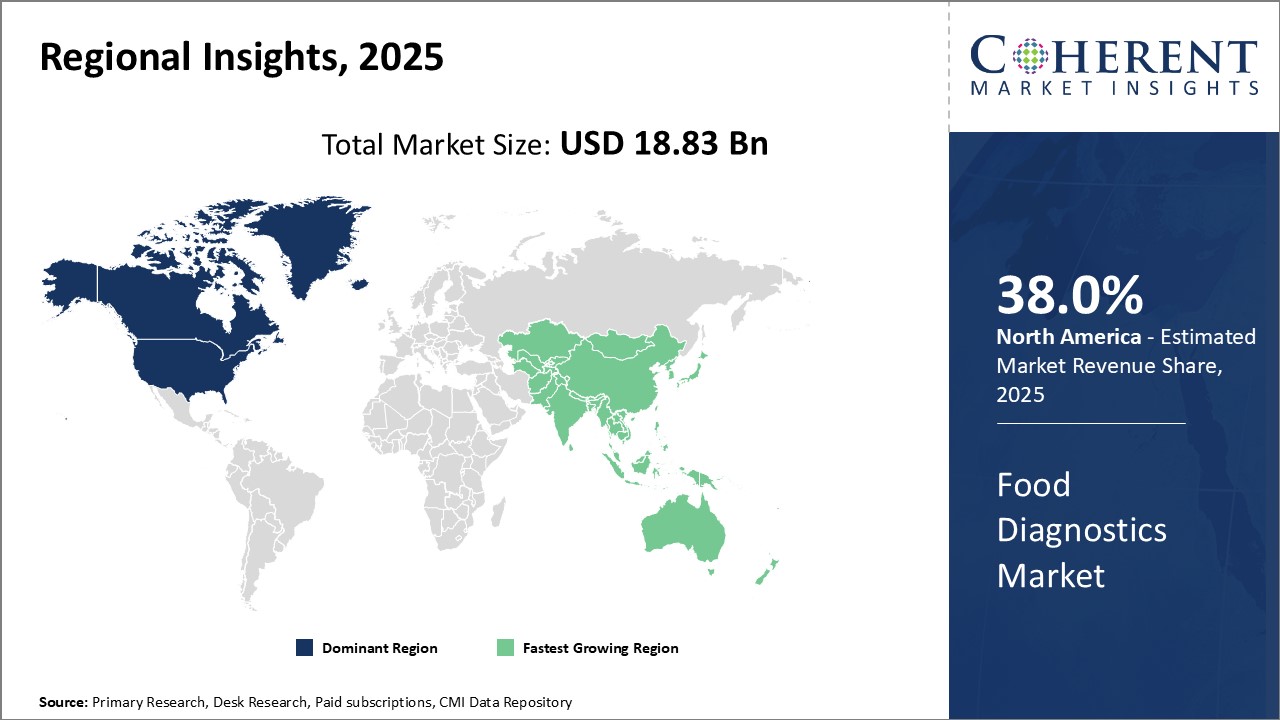Food Diagnostics Market Size and Trends
The global food diagnostics market is estimated to be valued at USD 18.83 Bn in 2025 and is expected to reach USD 32.08 Bn by 2032, exhibiting a compound annual growth rate (CAGR) of 7.9% from 2025 to 2032.

Discover market dynamics shaping the industry: Download Free Sample
Advancements in pathogen detection technologies, rising instances of foodborne illnesses, and increasing awareness about food safety and quality are fueling the market growth.
Market Driver - Rising implementation of stringent food safety regulations
With globalization of food supply chains and increasing instances of food contamination, governments around the world are implementing stringent food safety regulations to protect consumers from health issues. Countries are harmonizing their food laws with international standards and increasing surveillance, traceability and accountability within the supply chain. In the U.S., the enforcement of Food Safety Modernization Act has strengthened import controls and mandated implementation of prevention-based food safety systems by food businesses. Companies are now required to analyze risks and implement science-based controls from farm to table. FSMA has increased the compliance burden but is necessary to make food system more transparent and ensure food reaching consumers is safe.
In Europe, the enforcement of General Food Law and other related regulations have been tightened. Food businesses face strict audits and must adhere to standards on food ingredients, packaging, labeling and traceability. Recent revisions to General Food Law have increased legal liability of companies in case of non-compliance. Traceability from raw material source to final product has become pivotal to contain cross-contamination incidents. The European Commission also actively monitors food imports and conducts audits of trading partners to assure only compliant products reach European Union market. Brexit has added another layer of complexity for UK businesses to align with new import rules of European Union.
Similar trends are seen in other developed and major developing nations like China, India, and Brazil. Governments want to boost consumers' trust in local produce and imports. Although stringent regulations increase operational costs, food companies have no option but to strengthen quality management systems, invest in testing and bring more transparency in supply chains. Non-compliance can lead to huge financial and reputational losses. As regulations globally become more science-based, harmonized and enforcement tightens, food diagnostics industry stands to benefit from increased testing demand. Solutions around testing, certification, inspection and traceability see more uptake.
Market Concentration and Competitive Landscape

Get actionable strategies to beat competition: Download Free Sample
Growing outbreaks of foodborne illnesses
Rise in international food trade and long complex supply chains have increased risk of cross-contamination and spread of pathogens globally. Fast evolving microbial threats and antimicrobial resistance also pose challenges. Although more outbreaks get reported due to better surveillance, increasing instances indicate food safety still requires a lot of progress. Every year, globally close to 600 million people - almost one in 10 - fall ill after consuming contaminated food. Of these, around 420,000 people die, majority being children under the age of five. Developing nations report a bigger share of burden but even developed country consumers are not spared.
A few high-profile incidents have dented consumer trust in recent times. Other notable outbreaks were linked to salmonella in papayas, chicken and eggs in different parts of world. Handling of fresh produce from farm to retail continues to pose challenges given the propensity of pathogens to survive and spread. Mitigation requires strategies around on-farm hygiene, pest/wildlife control, water quality, packing/processing hygiene and timely recalls.
With rising awareness, consumers are increasingly demanding assurance on safety of foods they consume. They closely follow new outbreak reports and expect companies and regulators to act decisively through testing, traceability and recalls. Whereas developed world sees lower tolerance for risk today due to widespread availability of food options; developing countries need to strengthen basic food safety infrastructure to reduce illness burden. Therefore, governments and food businesses recognize ongoing need to bolster surveillance systems and adopt modern preventive controls through technologies like diagnostics testing. This is driving continued growth for food diagnostics industry.
Key Takeaways from Analyst:
The global food diagnostics market is projected to experience significant growth over the forecast period driven by rising food safety concerns among consumers and stringent government regulations for food safety. The market is driven by factors such as increasing instances of foodborne illnesses and food contamination incidents. Adoption of rapid testing methods is expected to create new opportunities in the market. North America currently dominates the global market however fastest growth is likely to be witnessed in Asia Pacific region supported by growing middle class population, rising disposable incomes and their spending on food items.
The market is restrained by high capital investment required for developing and procuring technologically advanced food diagnostic systems. Lack of food control infrastructure and technical expertise in developing regions also hinders market growth. Market players should focus on developing affordable and easy-to-use testing solutions targeted towards price-sensitive markets. They must also explore opportunities to provide food testing services as this can help overcoming challenges related to high capital investment and expertise required for in-house testing.
Collaboration with government bodies and regulators is key to establish standards and protocols. Adoption of integrated solutions for multiple test parameters can help reduce operational costs for end-users. New product innovation and M&A activities are expected to further consolidate competition. Companies need to closely track regulations in high growth developing markets to position themselves suitably.
Market Challenges : High cost of instrument and testing procedures
One of the major challenges faced by the global food diagnostics market is the high cost of instruments and testing procedures. The techniques and instruments used for various food testing such as PCR systems, chromatography devices, and spectrophotometers are quite expensive. This becomes a significant hurdle, especially for small and medium scale food companies in developing countries to implement robust food safety testing programs. The maintenance of these sophisticated instruments and regular calibration processes also involves substantial costs. Furthermore, the microbiological and chemical testing methods prescribed by regulatory bodies are often labor intensive and time-consuming. Conducting multiple tests on each food batch pushes up the overall cost of quality control and assurance for food businesses. The expensive food diagnostics solutions are a deterrent for companies in emerging low and middle-income markets to strengthen their food safety management systems. Overall, the high capital investment and operating expenses associated with various food pathology instruments and diagnosis methods pose a notable challenge for the broader growth of the global food diagnostics market.
Market Opportunities: Untapped emerging markets for market
One of the major opportunities for the global food diagnostics market lies in tapping the emerging markets of developing economies. While food safety is a priority in almost all countries, the diagnostics solutions available are not adequately accessible or affordable for the food industry of many developing nations. This results in a large proportion of global food production and supply being untested or under tested. As the economies progress and consumer purchasing power increases, the demand for safer and higher quality food will surge in emerging markets across Asia Pacific, Latin America, Middle East, and Africa. This provides substantial scope for diagnostic solution providers to penetrate these previously underserved regions. By developing low-cost instruments, miniaturized portable devices and simplified testing methodologies, companies can make their offerings more suitable for the needs in emerging markets. This will help drive the adoption of preventive food safety practices among smaller food businesses as well. Thus, catering to the untapped emerging markets through customized affordable solutions can open big opportunities for continued growth of the global food diagnostics market.

Discover high revenue pocket segments and roadmap to it: Download Free Sample
Insights by type: Pathogens Testing Dominates Food Diagnostics Market Due to Safety Concerns
Pathogens testing is expected to contribute 35.0% estimated share of the global food diagnostics market in 2025, owing to growing safety concerns around foodborne illnesses. Detecting potentially harmful pathogens in food products helps ensure contaminated items don't reach consumers and cause outbreaks. Various pathogens like salmonella, E. coli, and listeria can cause severe illnesses if ingested, especially in high-risk groups like young children, elderly, and those with weaker immune systems. With increasing globalization of food supply chains, outbreaks can spread rapidly across borders. This amplifies the risks and consequences of contaminated foods.
Companies face significant financial and legal liabilities if pathogens testing is not done properly and tainted products are distributed. Recalls can cost millions of dollars to organize and damage brand reputation. Governments worldwide have strengthened rules and enforcement around food safety in recent years. Pathogens testing is now mandatory for many product categories before distribution. Regulated Hazard Analysis and Critical Control Point (HACCP) systems must be in place to identify and minimize contamination risks. Large retailers also demand comprehensive testing from suppliers as it protects their brands and safeguards public health.
New genomic-based pathogen detection methods are gaining ground. Technologies like PCR, immunoassays, and chromatography offer faster and more accurate detection of a wide range of pathogens compared to traditional cultures and plating. Portable and microfluidic immunoassay test kits also allow on-site screening during production and processing. This enables real-time monitoring and intervention if issues arise. Advances will continue boosting pathogens testing capacity, automating procedures, and reducing turnaround times for reports. With growing health-conscious consumers, companies must assure food safety to build long-term trust and loyalty. Therefore, pathogens testing is strategically important for quality assurance in the food industry.
Insights by Sample Type: Meat, Poultry, and Seafood Driving Food Diagnostics Due to Contamination Risks
The meat, poultry, and seafood segment is expected to contribute 30.9% estimated share of the global food diagnostics market in 2025, owing to high contamination risks in animal protein supply chains. Meats are susceptible to pathogens like salmonella and E.coli that may be present in animal intestinal tracts. Improper handling and processing create opportunities for cross-contamination onto muscle tissues and organs. Seafood also faces microbiological hazards and accumulation of marine toxins in shellfish. With global trade in fresh and frozen meats growing rapidly, outbreaks can spread internationally within days if contaminated products are not contained quickly.
Ensuring meat, poultry, and seafood products are free of harmful residues is another key application for diagnostics. Antibiotics, pesticides, steroids and other chemicals must be tested to comply with strict regulatory limits and protect consumer health. Detection technologies play a vital role for regulatory agencies during foodborne illness outbreak investigations by tracing microbial fingerprints back to implicated sources. Rapid and accurate diagnostics allow authorities to determine contamination origins fast and issue targeted recalls to limit economic and social impacts.
Adoption of advanced high-throughput technologies is driving diagnostics in this segment. Genetic methods like PCR and DNA microarrays allow sensitive, simultaneous screening of multiple contaminants. Spectrometry, chromatography and biosensors also enable multi-analyte residue screening. Portable on-site devices further enhance monitoring throughout complex supply chains. With rising demand for transparency, companies face pressures to demonstrate rigorous safety standards from farm to table. Hence, diagnostics assume strategic importance for quality assurance in the meat, poultry and seafood industry.
Regional Insights

Need a Different Region or Segment? Download Free Sample
North America dominates the global food diagnostics market. The region is expected to account for 38.0% of the market share in 2025. The large size of the region's food industry coupled with stringent government regulations has led to the widespread adoption of advanced food diagnostics solutions across all verticals such as meat, poultry, seafood, dairy, processed food, and grains & cereals. Major global players have established their headquarters as well as R&D centers in the region in order to cater to the demand from local players and tap into new opportunities. Furthermore, the presence of a strong economy allows companies to continuously invest in the latest technologies, developing customized solutions for various industry players.
On the other hand, Asia Pacific has emerged as the fastest growing region over the past few years. Countries, such as China, India, and Indonesia, are witnessing robust economic expansion along with rising disposable incomes. This has increased the demand for safe, nutritious, and high-quality food. Local producers are contracting international players to overhaul their quality control processes and install advanced diagnostics platforms to comply with rising sanitary standards. Additionally, governments in the region are collaborating with international agencies to implement effective regulations for curbing food fraud and contamination incidents. The young demography also indicates a thriving market in the future. The region has now become an export and manufacturing hub for many multinational food corporations. However, pricing pressure exists as local players are opting for affordable solutions.
Market Report Scope
Food Diagnostics Market Report Coverage
| Report Coverage | Details | ||
|---|---|---|---|
| Base Year: | 2024 | Market Size in 2025: | USD 18.83 Bn |
| Historical Data for: | 2020 To 2024 | Forecast Period: | 2025 To 2032 |
| Forecast Period 2025 to 2032 CAGR: | 7.9% | 2032 Value Projection: | USD 32.08 Bn |
| Geographies covered: |
|
||
| Segments covered: |
|
||
| Companies covered: |
Ring Biotechnology Co Ltd., Thermo Fisher Scientific Inc., Danaher, Merck KGaA, Neogen Corporation, Agilent Technologies, Inc., Bio-Rad Laboratories, Inc., Shimadzu Corporation, BioMerieux, Bruker, QIAGEN, PerkinElmer Inc., FOSS, Hygiena LLC, R-Biopharm AG, Romer Labs Division Holding, EnviroLogix, Randox Food Diagnostics (Ireland), Promega Corporation, and PathogenDx Corporation |
||
| Growth Drivers: |
|
||
| Restraints & Challenges: |
|
||
Uncover macros and micros vetted on 75+ parameters: Get instant access to report
Food Diagnostics Industry News
- In February 2024, BioMérieux announced a partnership with the U.S. Food and Drug Administration (FDA) to develop advanced molecular tools aimed at enhancing food safety. This collaboration focuses on leveraging innovative technologies to improve the detection and monitoring of foodborne pathogens.
- In 2023, Agilent Technologies, Inc. launched the 6495 Triple Quadrupole LC/MS System, specifically engineered to meet the demands of research and testing laboratories that handle high-volume sample processing
- In 2022, Neogen Corporation successfully completed its merger with 3M's Food Safety business, representing a significant advancement in establishing a leading position within the food safety industry.
- In 2022, Thermo Fisher Scientific Inc. formed a strategic partnership with LabShares Newton to enhance the Boston biotech ecosystem. This collaboration is designed to provide cutting-edge instruments, laboratory equipment, and essential consumables to support emerging life sciences companies in their efforts to advance drug discovery.
*Definition: The global food diagnostics market involves testing and screening technologies and reagents used to test food products for contamination, allergens, pathogens, GMOs, and meat speciation. The market includes testing technologies like chromatography, spectroscopy, immunoassays, PCR, and hybridization, which are used for various applications such as meat, poultry, and seafood testing; dairy testing; GMO testing; gluten intolerance testing; allergens testing; nanoparticles testing; and pesticides and toxins testing.
Market Segmentation
- Type Insights (Revenue, USD Bn, 2020 - 2032)
-
- Pathogens Testing
- Allergens Testing
- Toxins/Contaminants Testing
- Residues Testing
- Others
- Sample Type Insights (Revenue, USD Bn, 2020 - 2032)
- Meat, Poultry, and Seafood
- Dairy Products
- Fruits and Vegetables
- Processed Foods
- Beverages
- Regional Insights (Revenue, USD Bn, 2020 - 2032)
- North America
- U.S.
- Canada
- Latin America
- Brazil
- Argentina
- Mexico
- Rest of Latin America
- Europe
- Germany
- U.K.
- Spain
- France
- Italy
- Russia
- Rest of Europe
- Asia Pacific
- China
- India
- Japan
- Australia
- South Korea
- ASEAN
- Rest of Asia Pacific
- Middle East & Africa
- GCC Countries
- Israel
- Rest of Middle East & Africa
- North America
- Key Players Insights
- Ring Biotechnology Co Ltd.
- Thermo Fisher Scientific Inc.
- Danaher
- Merck KGaA
- Neogen Corporation
- Agilent Technologies, Inc.
- Bio-Rad Laboratories, Inc.
- Shimadzu Corporation
- BioMerieux
- Bruker
- QIAGEN
- PerkinElmer Inc.
- FOSS
- Hygiena LLC
- R-Biopharm AG
- Romer Labs Division Holding
- EnviroLogix
- Randox Food Diagnostics (Ireland)
- Promega Corporation
- PathogenDx Corporation
Share
Share
About Author
Yash Doshi is a Senior Management Consultant. He has 12+ years of experience in conducting research and handling consulting projects across verticals in APAC, EMEA, and the Americas.
He brings strong acumen in helping chemical companies navigate complex challenges and identify growth opportunities. He has deep expertise across the chemicals value chain, including commodity, specialty and fine chemicals, plastics and polymers, and petrochemicals. Yash is a sought-after speaker at industry conferences and contributes to various publications on topics related commodity, specialty and fine chemicals, plastics and polymers, and petrochemicals.
Missing comfort of reading report in your local language? Find your preferred language :
Transform your Strategy with Exclusive Trending Reports :
Frequently Asked Questions
EXISTING CLIENTELE
Joining thousands of companies around the world committed to making the Excellent Business Solutions.
View All Our Clients
